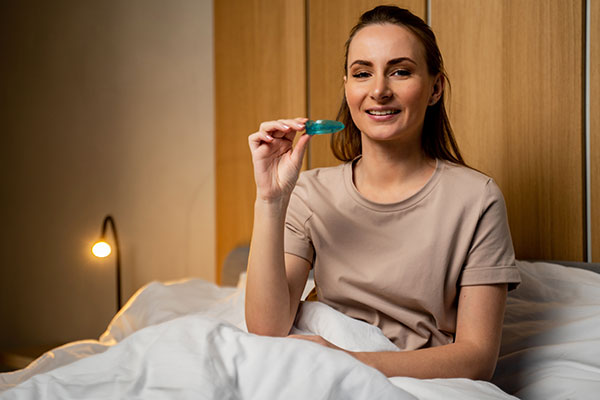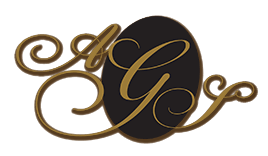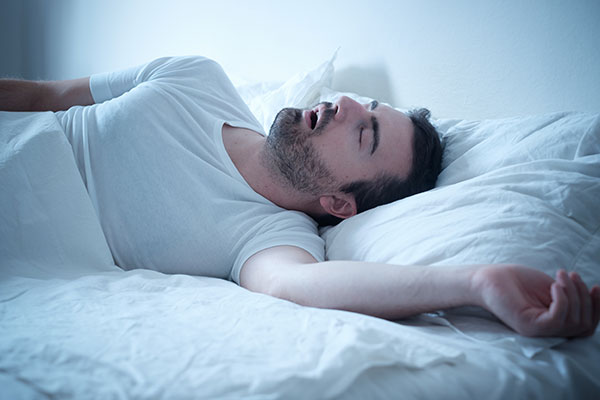Get the Rest You Deserve
Imagine finally waking up refreshed and energized after a full night’s sleep, free from the constant interruptions of snoring and sleep apnea. Mandibular Advancement Devices (MADs) offer a solution that can make this dream a reality for many sleep apnea sufferers.
If you’re curious about oral appliance therapy for sleep apnea, contact our dental office in Sacramento to get started. Call our dentist at (916) 929-9222 to schedule an appointment.

Sleep Apnea and Its Impact
Sleep apnea is a disorder characterized by breathing pauses during sleep, leading to disrupted sleep quality. These interruptions are caused by obstructions in the upper airway, often due to tissue at the back of the throat. Common sleep apnea symptoms include loud snoring, morning headaches, and fatigue.
Left untreated, sleep apnea can result in chronic fatigue, poor concentration, and even serious health complications such as high blood pressure, heart disease, and stroke. OSA, also known as obstructive sleep apnea, is the most common form of the disorder. Fortunately, there are various treatment options available designed to tackle moderate obstructive sleep apnea and snoring issues.
Mandibular Advancement Devices
Mandibular Advancement Devices, or MADs, are custom-made oral appliances designed to treat mild to moderate sleep apnea, snoring, and teeth grinding by expanding the airway through a forward movement of the jaw. Available in both custom and semi-custom designs, MADs are a popular sleep apnea treatment option.
Benefits of MADs
Patients can experience various benefits with a custom MAD, including:
- Non-Invasive: MADs don’t require surgery or invasive procedures, making them a less intimidating treatment option.
- Improved Compliance: Many patients find MADs more comfortable and easier to use compared to CPAP (continuous positive airway pressure) machines.
- Portability and Convenience: MADs are compact and don’t rely on electricity, making them suitable for travel and use in various settings.
Ideal Candidates for MAD Therapy
MADs are generally effective for individuals with specific characteristics and conditions. Ideal candidates often include those who have:
- Mild to Moderate OSA: MADs are typically recommended for individuals with mild to moderate OSA. These individuals experience fewer apnea and hypopnea events during sleep compared to those with severe OSA. If you have been diagnosed with mild to moderate OSA, MADs may be a suitable treatment choice.
- Intolerance to CPAP Therapy: CPAP therapy is a common alternative for treating OSA. However, some individuals find it uncomfortable or struggle with compliance due to the mask and air pressure. If you can’t tolerate CPAP therapy or prefer a non-invasive option, MADs may be a good alternative.
- Preference for Non-Invasive Solutions: MADs are non-invasive and don’t require surgery or other invasive procedures. If you’re looking for a treatment option that doesn’t involve medical interventions or machines, MADs are worth considering.
- Anatomically Suitability: Successful use of MADs often depends on the anatomy of your oral cavity and jaw. Ideal candidates have a jaw and tongue structure that allows for the repositioning required by MADs.
- Good Dental Health: MADs can potentially impact dental health, particularly bite alignment. Ideal candidates have good dental health and are committed to maintaining it through regular dental check-ups and proper device care.
- No Central Sleep Apnea: MADs are primarily designed for obstructive sleep apnea (OSA), which results from physical obstructions in the airway. They’re generally not effective for central sleep apnea, a type of sleep apnea not related to airway obstruction.
The Process for Getting Your MAD
When looking for MADs as a treatment option, patients can expect the following process:
- Consultation: Seek guidance from a sleep specialist or dentist experienced in sleep medicine to determine if MADs are suitable for you. They’ll perform a physical examination, which may include an assessment of your oral anatomy. This examination helps determine if you’re a suitable candidate for MAD therapy.
- Customization and Fitting: MADs are not one-size-fits-all; they must be tailored to your mouth’s unique shape and size. The dental professional will take impressions or digital scans of your teeth and oral structures. Using these impressions, the MAD will be fabricated to ensure a comfortable and secure fit in your mouth. Proper fit is essential to optimize the device’s effectiveness and minimize potential side effects.
- Follow-Up Appointments: Regular follow-up appointments are essential to monitor device effectiveness and make any necessary adjustments.
Side Effects and Adjustment Period
Potential side effects come hand in hand with any medical treatment, including MADs. Common side effects of oral appliances include:
- Dry Mouth: One of the most frequently reported side effects of MADs is dry mouth. This occurs because the device repositions the lower jaw, which can lead to increased airflow through the mouth, potentially causing dryness. Staying well-hydrated and using a humidifier in your bedroom can help alleviate this issue.
- Excessive Salivation: Some individuals experience increased salivation when wearing MADs. This is usually a temporary issue as your body adapts to the device. Over time, salivation tends to normalize for most users.
- Jaw Discomfort: MADs work by repositioning the lower jaw, and this change in jaw position can lead to temporary discomfort or soreness. This discomfort typically occurs during the initial adjustment period and may improve with time.
- Dental Changes: Long-term use of MADs can, in some cases, lead to minor dental changes or alterations in bite alignment. Regular dental check-ups are important to monitor and address any potential issues.
- Tongue Discomfort: Occasionally, individuals may experience mild tongue discomfort or soreness due to the position of the tongue within the device. This, too, usually diminishes as your body adapts to the MAD.
When it comes to adjusting to your dental device, it can take a few weeks. During the first few nights of wearing your appliance, you may experience some initial discomfort, particularly in the jaw area. This discomfort is usually temporary and tends to improve as your muscles adapt to the new jaw position.
If you’re having trouble adjusting to your appliance, contact our dentist as soon as possible for an evaluation.
Costs
When receiving a MAD, patients can expect to spend between $500 to $2,000 depending on various factors. These factors include:
- Type of MAD: There are different types of MADs available, ranging from standard, over-the-counter devices to custom-made, prescription MADs. Custom-made MADs, which are fabricated to fit your mouth precisely, are generally more expensive than generic, non-customized options.
- Insurance Coverage: Some health insurance plans may cover a portion of the costs associated with MADs. Coverage varies widely among insurance providers and plans. Check with your insurance company to determine whether MADs are covered and what portion of the costs you may be responsible for.
- Replacement and Maintenance Costs: MADs have a lifespan, and they may need replacement over time. Additionally, you should budget for maintenance costs, such as cleaning supplies and any necessary repairs.
To get an estimate, contact our dental office today for an appointment.
Frequently Asked Questions
Do mandibular advancement devices work?
Mandibular advancement devices are effective in treating snoring and obstructive sleep apnea, with minimal side effects and a cost-effective nature. However, not everyone finds them to be successful.
How do I clean my MAD?
To clean your MAD, use a soft toothbrush and mild, non-abrasive toothpaste. Gently scrub the device, paying attention to all surfaces, including the inner and outer parts. Rinse it thoroughly with cold water before using it again. It’s recommended to clean your MAD every morning after use.
Sleep Better and Feel Better!
Custom oral appliances offer a promising solution for individuals suffering from sleep apnea and snoring. With a variety of customization options and proven effectiveness in reducing symptoms, MADs provide a valuable alternative treatment to other treatment options such as CPAP and lifestyle modifications.
As you consider your options for treating sleep apnea, remember that the right treatment choice is unique to your individual needs and preferences. To schedule an appointment with our sleep dentist in Sacramento, call us today at (916) 929-9222.

